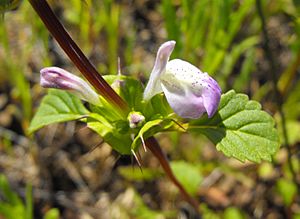San Diego thornmint facts for kids
Quick facts for kids Acanthomintha ilicifoliaSan Diego thornmint |
|
|---|---|
 |
|
| Conservation status | |
| Scientific classification | |
| Genus: |
Acanthomintha
|
| Species: |
ilicifolia
|
The San Diego thornmint (Acanthomintha ilicifolia) is a very special and rare flowering plant. It belongs to the mint family, just like the mint you might use in chewing gum! This small plant grows naturally in only a few places. You can find it in Baja California (which is in Mexico) and San Diego County, California (in the United States).
This plant loves to live in certain types of environments. It grows in areas called chaparral and coastal sage scrub. These are places with dry, shrubby plants. It also likes vernal pools, which are temporary ponds that fill with water in the rainy season and then dry up.
Sadly, the San Diego thornmint has disappeared from many places in San Diego County where it used to grow. When a plant or animal disappears from a specific area, it's called being extirpated. Because it's so rare, the United States government lists it as a threatened species. This means it's protected by law to help it survive. In California, it's even listed as an endangered species. This makes it illegal to harm or collect these plants without special permission from the California Department of Fish and Game.
What Does It Look Like?
The San Diego thornmint is a small plant. It grows as an annual herb, which means it lives for only one growing season. It starts from a seed, grows, flowers, makes new seeds, and then dies, all within a year.
Size and Leaves
This little plant usually grows up to about 15 centimeters tall. That's about the length of a standard pencil! Its leaves are rounded or oval-shaped. They have small, jagged edges, like tiny teeth, and can be up to 1.5 centimeters long.
Flowers and Spines
The flowers of the San Diego thornmint grow in clusters. Each cluster has special oval-shaped leaves called bracts. These bracts are very interesting because they have long, sharp spines along their edges. The spines can be nearly a centimeter long.
Each individual flower is about a centimeter wide. They are usually white, but sometimes they have hints of purple or pink. The flower has two main parts, like lips. The upper lip looks like a small hood, and the lower lip is a little bit longer.
See also
 In Spanish: Acanthomintha ilicifolia para niños
In Spanish: Acanthomintha ilicifolia para niños


